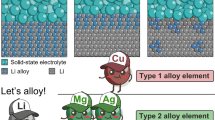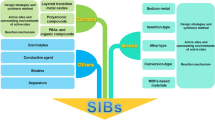Abstract
In order to predict the actual performance of battery materials in full cells more easily and accurately, this work systematically studies the fabrication process of coin full cells. By exploring a series of key factors corresponding to the N/P ratio of different active materials, the type of separator, the amount of electrolyte injections, and the relative size of the electrode area, a set of full coin cell preparation process with high repeatability and reliable data is constructed. After optimizing the key parameters, the prepared full coin cells have good consistency and stable performance, and graphite||NCM712 cells can maintain a capacity retention rate of 83.4% at 0.5 C after 200 cycles. Based on the results in this work, researchers can design and prepare their own full coin cells and can more easily and quickly obtain the actual performance of various aspects of the material.






Similar content being viewed by others
Data availability
Date will be made available on request.
References
Kang KS, Meng YS, Breger J, Grey CP, Ceder G (2006) Electrodes with high power and high capacity for rechargeable lithium batteries. Science 311(5763):977–980. https://doi.org/10.1126/science.1122152
Reddy ALM, Nagarajan S, Chumyim P, Gowda SR, Pradhan P, Jadhav SR, Dubey M, John G, Ajayan PM (2012) Lithium storage mechanisms in purpurin based organic lithium ion battery electrodes. Sci Rep 2:5. https://doi.org/10.1038/srep00960
Li WD, Song BH, Manthiram A (2017) High-voltage positive electrode materials for lithium-ion batteries. Chem Soc Rev 46(10):3006–3059. https://doi.org/10.1039/c6cs00875e
Nitta N, Wu FX, Lee JT, Yushin G (2015) Li-ion battery materials: present and future. Mater Today 18(5):252–264. https://doi.org/10.1016/j.mattod.2014.10.040
Chen SR, Niu CJ, Lee H, Li QY, Yu L, Xu W, Zhang JG, Dufek EJ, Whittingham MS, Meng S, Xiao J, Liu J (2019) Critical parameters for evaluating coin cells and pouch cells of rechargeable Li-metal batteries. Joule 3(4):1094–1105. https://doi.org/10.1016/j.joule.2019.02.004
Bower AF, Guduru PR, Sethuraman VA (2011) A finite strain model of stress, diffusion, plastic flow, and electrochemical reactions in a lithium-ion half-cell. J Mech Phys Solids 59(4):804–828. https://doi.org/10.1016/j.jmps.2011.01.003
Wang DY, Sinha NN, Petibon R, Burns JC, Dahn JR (2014) A systematic study of well-known electrolyte additives in LiCoO2/graphite pouch cells. J Power Sources 251:311–318. https://doi.org/10.1016/j.jpowsour.2013.11.064
Wang DY, Xia J, Ma L, Nelson KJ, Harlow JE, Xiong DJ, Downie LE, Petibon R, Burns JC, Xiao A, Lamanna WM, Dahn JR (2014) A systematic study of electrolyte additives in Li Ni1/3Mn1/3Co1/3 O-2 (NMC)/graphite pouch cells. J Electrochem Soc 161(12):A1818–A1827. https://doi.org/10.1149/2.0511412jes
Aiken CP, Self J, Petibon R, Xia X, Paulsen JM, Dahn JR (2015) A survey of in situ gas evolution during high voltage formation in Li-ion pouch cells. J Electrochem Soc 162(4):A760–A767. https://doi.org/10.1149/2.0941504jes
Petibon R, Chevrier VL, Aiken CP, Hall DS, Hyatt SR, Shunmugasundaram R, Dahn JR (2016) Studies of the capacity fade mechanisms of LiCoO2/Si-alloy: graphite cells. J Electrochem Soc 163(7):A1146–A1156. https://doi.org/10.1149/2.0191607jes
Murray V, Hall DS, Dahn JR (2019) A guide to full coin cell making for academic researchers. J Electrochem Soc 166(2):A329–A333. https://doi.org/10.1149/2.1171902jes
Kim N, Byun S, Jin D, Dzakpasu CB, Park SH, Lee H, Hong ST, Lee YM (2022) Electrode alignment: ignored but important design parameter in assembling coin-type full lithium-ion cells. J Electrochem Soc 169(2):9. https://doi.org/10.1149/1945-7111/ac4f23
Hu JT, Wu BB, Chae SJ, Lochala J, Bi YJ, Xiao J (2021) Achieving highly reproducible results in graphite-based Li-ion full coin cells. Joule 5(5):1011–1015. https://doi.org/10.1016/j.joule.2021.03.016
Son B, Ryou MH, Choi J, Kim SH, Ko JM, Lee YM (2013) Effect of cathode/anode area ratio on electrochemical performance of lithium-ion batteries. J Power Sources 243:641–647. https://doi.org/10.1016/j.jpowsour.2013.06.062
Dagger T, Kasnatscheew J, Vortmann-Westhoven B, Schwieters T, Nowak S, Winter M, Schappacher FM (2018) Performance tuning of lithium ion battery cells with area-oversized graphite based negative electrodes. J Power Sources 396:519–526. https://doi.org/10.1016/j.jpowsour.2018.06.043
Long BR, Rinaldo SG, Gallagher KG, Dees DW, Trask SE, Polzin BJ, Jansen AN, Abraham DP, Bloom I, Bareno J, Croyz JR (2016) Enabling high-energy, high-voltage lithium-ion cells: standardization of coin-cell assembly, electrochemical testing, and evaluation of full cells. J Electrochem Soc 163(14):A2999–A3009. https://doi.org/10.1149/2.0691614jes
Marks T, Trussler S, Smith AJ, Xiong DJ, Dahn JR (2011) A guide to Li-ion coin-cell electrode making for academic researchers. J Electrochem Soc 158(1):A51–A57. https://doi.org/10.1149/1.3515072
Gu M, Belharouak I, Zheng JM, Wu HM, Xiao J, Genc A, Amine K, Thevuthasan S, Baer DR, Zhang JG, Browning ND, Liu J, Wang CM (2013) Formation of the spinel phase in the layered composite cathode used in Li-ion batteries. ACS Nano 7(1):760–767. https://doi.org/10.1021/nn305065u
Chen Z, Zhang L, Wu XK, Song KF, Ren BZ, Li T, Zhang SJ (2019) Effect of N/P ratios on the performance of LiNi0.8Co0.15Al0.05O2 parallel to SiOx/graphite lithium-ion batteries. J Power Sources 439:7. https://doi.org/10.1016/j.jpowsour.2019.227056
Abe Y, Kumagai S (2018) Effect of negative/positive capacity ratio on the rate and cycling performances of LiFePO4/graphite lithium-ion batteries. J Energy Storage 19:96–102. https://doi.org/10.1016/j.est.2018.07.012
Wang AP, Kadam S, Li H, Shi SQ, Qi Y (2018) Review on modeling of the anode solid electrolyte interphase (SEI) for lithium-ion batteries. npj Comput Mater 4:26. https://doi.org/10.1038/s41524-018-0064-0
Li WD, Liu XM, Xie Q, You Y, Chi MF, Manthiram A (2020) Long-term cyclability of NCM-811 at high voltages in lithium-ion batteries: an in-depth diagnostic study. Chem Mater 32(18):7796–7804. https://doi.org/10.1021/acs.chemmater.0c02398
Park G, Gunawardhana N, Nakamura H, Lee Y, Yoshio M (2011) Suppression of Li deposition on surface of graphite using carbon coating by thermal vapor deposition process. J Power Sources 196(22):9820–9824. https://doi.org/10.1016/j.jpowsour.2011.07.006
Luiso S, Fedkiw P (2020) Lithium-ion battery separators: recent developments and state of art. Curr Opin Electrochem 20:99–107. https://doi.org/10.1016/j.coelec.2020.05.011
Wachs SJ, Behling C, Ranninger J, Moller J, Mayrhofer KJJ, Berkes BB (2021) Online monitoring of transition-metal dissolution from a high-Ni-content cathode material. ACS Appl Mater Interfaces 13(28):33075–33082. https://doi.org/10.1021/acsami.1c07932
Gunter FJ, Burgstaller C, Konwitschny F, Reinhart G (2019) Influence of the electrolyte quantity on lithium-ion cells. J Electrochem Soc 166(10):A1709–A1714. https://doi.org/10.1149/2.0121910jes
Funding
This work was financially supported by the National Natural Science Foundation of China (Grant Nos. 51874358 and 51772333).
Author information
Authors and Affiliations
Contributions
Zhiyuan Xue: conceptualization, methodology, formal analysis, investigation, data curation, software, visualization, writing - original draft.
Dichang Guan: methodology, investigation, proofreading the article.
Jingyao Zeng: providing language help, grammar.
Yanbing Cao: conceptualization, funding acquisition.
Zhongdong Peng: formal analysis, supervision, validation.
Guorong Hu: conceptualization, methodology.
Ke Du: investigation, resources, formal analysis.
Corresponding author
Ethics declarations
Ethical approval
This declaration is “not applicable.”
Conflict of interest
The authors declare no competing interests.
Additional information
Publisher’s Note
Springer Nature remains neutral with regard to jurisdictional claims in published maps and institutional affiliations.
Supplementary information
Rights and permissions
Springer Nature or its licensor (e.g. a society or other partner) holds exclusive rights to this article under a publishing agreement with the author(s) or other rightsholder(s); author self-archiving of the accepted manuscript version of this article is solely governed by the terms of such publishing agreement and applicable law.
About this article
Cite this article
Xue, Z., Guan, D., Zeng, J. et al. Research on the assembly process of full coin cells: key factors affecting data reliability. Ionics 29, 5285–5293 (2023). https://doi.org/10.1007/s11581-023-05225-2
Received:
Revised:
Accepted:
Published:
Issue Date:
DOI: https://doi.org/10.1007/s11581-023-05225-2




